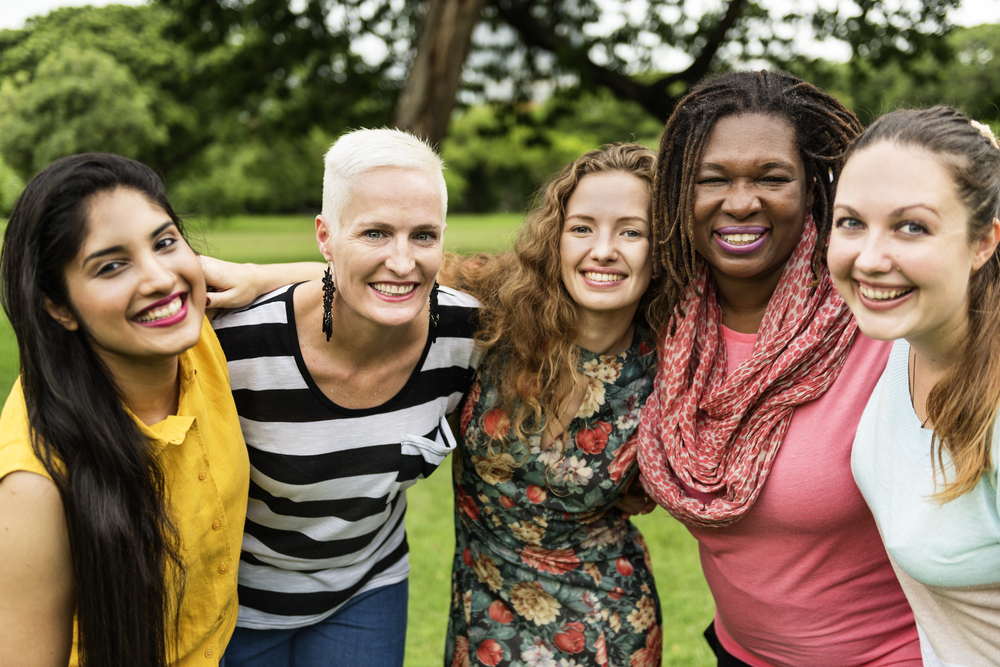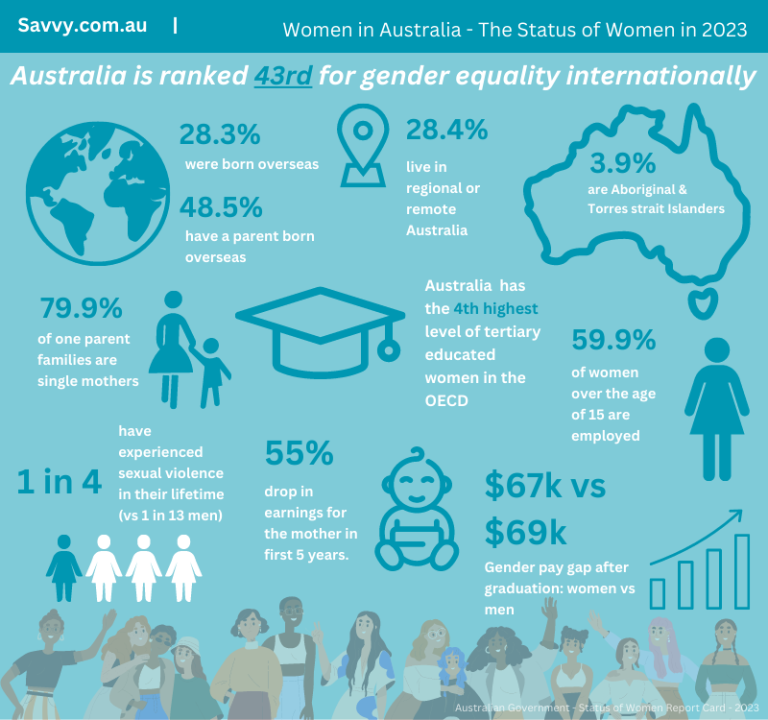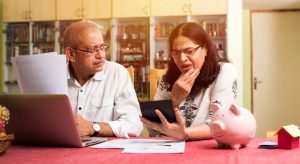
- The Savvy Promise
At Savvy, our mission is to empower you to make informed financial choices. While we maintain stringent editorial standards, this article may include mentions of products offered by our partners. Here’s how we generate income.
In this article
Despite Australia’s appearance as a vibrant liberal democracy with advanced economy, Australia is ranked 43rd for gender equality, according to the most recent Status of Women Report Card published by the Australian Government.
- Australia is ranked 43rd for gender equality internationally
- Australia has the 4th highest level of tertiary educated women in the OECD
- 9% are Aboriginal & Torres Strait Islander, 28.3% are born overseas, 48.5% have a parent born overseas
- 4% under 25 years and 18% over 65 years
By many metrics, there are a ways to go to achieve full gender equality. Some statistics are world-leading, such as the fact that Australia has the 4th highest level of tertiary educated women in the OECD. 63.3% – almost two thirds – hold a qualification outside of school, with 35.2% – a little over a third – hold a bachelors’ degree or higher.
Many statistics show that Women in Australia are diverse, highly educated, and work as hard as women in any other country.
28.3% of all women in Australia were born overseas, with almost half (48.5%) having a parent that was born overseas. 3.9% are Aboriginal and/or Torres Strait Islander.
17.8% of women live with a disability, and 28.4% live in regional or rural Australia.

Australian statistics on young women
29.4% of women in Australia are under the age of 25. Unfortunately, over the last 10 years, there has been a three-times increase in intentional self-harm hospitalisations for girls and young women.
Young women are more likely to report experiencing sexual violence in their lifetime: 51% of women born between 1989 to 1995 say they have; 34% of women born between 1973 and 1978 say they have; 26% of women of women born between 1946 and 1951 say they have reported sexual violence.
Young women are also more likely to report a recent experience of sexual harassment, with 38% of women aged 18 to 24 having reported such incidents, compared to 17.4% of women aged 35 to 44.
79.1% of heterosexual women and 86.6% of lesbian, gay, or bisexual (all non-heterosexual) women have experienced online sexual violence facilitated by dating apps. 35.4% of the former and almost half (49.5%) of the latter have experienced in-person sexual violence due to dating apps.
The basics: health, housing, and safety
When it comes to the basics such as health, housing, and safety, it seems there is still more work to be done to help empower women.
62% of renters in social housing are women, compared to 38% of males. Family and domestic violence is the main contributor to being homeless for women (For 40% of women, this is the key justification) − 25% of women who wish to leave a violent partner are unable to due to a lack of financial support − 15% of women who returned to a violent partner did so because they had nowhere else to go.
In their lives, 1 in 4 males and 1 in 2 women have both experienced some form of sexual harassment.
One woman is killed by an intimate partner every 10 days, and police complaints of sexual assault have grown for women by 33% over the past five years while remaining unchanged for men.
Single women make up the bulk of those receiving rent assistance (45% vs 30% for single males and 20% for couples).
Women over the age of 55 are the category of people experiencing homelessness who are witnessing the highest growth (up 31% from 2011 to 2016).
As for marginalised groups, Indigenous women are 34 times more likely to be hospitalised than non-Indigenous women and 25% of women with disabilities experienced sexual abuse since the age of 15. (compared to 15% without disability) Both endure greater rates of family, domestic, and/or sexual violence.
Approximately 1 in 5 women (20.7%) and 1 in 6 men (16.4%) have numerous chronic illnesses.
Women are more prone than males to develop eating disorders, post-traumatic stress disorder, and depression.
Endometriosis affects around 1 in 9 women. After the initial visit to the doctor, it often takes five years to acquire a diagnosis.
Career and family
In Australia, two thirds (59.9%) of women over the age of 15 are employed in some capacity. In an average week, women aged 15 to 64 years do 55.5 hours of work a week, two hours more than men. About 34.7 of these are unpaid.
Immediately after graduation, full-time starting salaries for women average $67,000 while salaries for men average $69,000. Lower paid occupations also tend to be female-dominated, with a pay gap for hourly earnings of 11.6%, a full-time weekly pay gap of 13.3% and a total annual taxable income pay gap of 29.2%.
Women worked 96.6% of the time as childcare providers, 86.9% of the time as licensed nurses, and 79% of the time as primary school teachers.
Compared to males (71.0%), women (62.1%) are less likely to engage in the workforce, and they are also more likely to work part-time (42.9%) than men (18.8%). This is also reflected in the lack of parity when it comes to parenthood and household chores.
In the first five years after becoming parents, women's wages decrease by 55% while men's remain unchanged.
Over nine hours per week more are spent on unpaid work and care by women than by males of all ages (31.6 hours versus 22.4 hours).
Even when they are the major provider of income (24.1 hours for women compared to 19.1 hours for men, a difference of 5 hours), women spend longer than men on unpaid housework.
Attitudes towards Australian women
Compared to the world on 21%, 30% of Australian men don’t believe that gender inequality actually exists. Some attitudes are changing but are still entrenched.
Among young men ages 16 to 24, 22% think that males should be the ones to make the decisions in partnerships, while 36% think that women prefer it this way.
Australian men (28%) are more likely than men from the US (17%), the UK (13%) and Canada (13%) to think that women frequently fabricate or exaggerate charges of sexual abuse or rape.
Almost a third (32%) of young men think that “many times, women who report they were raped had lured the man into sex and had remorse afterward”.
The percentage of Australians who realise that men are more likely than women to commit domestic violence is continuing to diminish, down from 74% in 2009 to 64% in 2017.
Australian women later in life
Compared to males their age, women approaching retirement had 23.1% less superannuation.
Initial research indicates that 28% of postmenopausal women in Australia will have moderate to severe symptoms that affect their ability to work, but more research is needed to understand the obstacles that women face when going through menopause.
Will 2024 see an improvement in the rankings for women? With a greater push for gender equality, these statistics can hopefully change for the better.
Did you find this page helpful?
Author
Savvy Editorial TeamPublished on March 16th, 2023
Last updated on March 14th, 2024
Fact checked
This guide provides general information and does not consider your individual needs, finances or objectives. We do not make any recommendation or suggestion about which product is best for you based on your specific situation and we do not compare all companies in the market, or all products offered by all companies. It’s always important to consider whether professional financial, legal or taxation advice is appropriate for you before choosing or purchasing a financial product.
The content on our website is produced by experts in the field of finance and reviewed as part of our editorial guidelines. We endeavour to keep all information across our site updated with accurate information.










